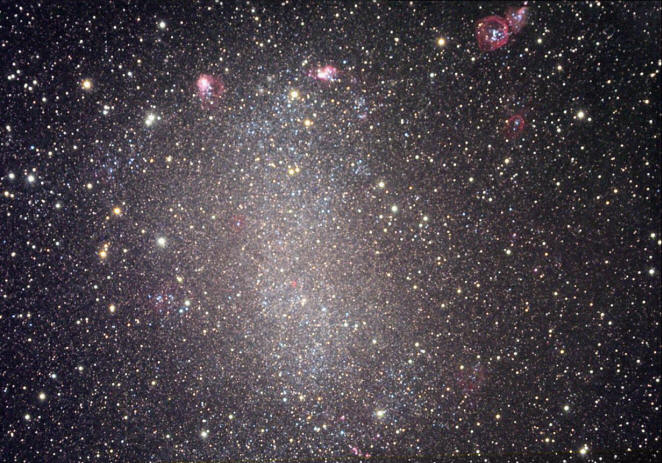|
|
Scraps of Cosmic Electricity
Oct 19, 2009
Lab discharges throw off wisps of
plasma. So too do intergalactic
discharges.
Barnard’s Galaxy is a loose
assemblage of a few million stars.
(In contrast, the Milky Way is
estimated to have several hundred
billion.) Because of its
shapelessness and small size, it’s
classified as an irregular dwarf,
one of several dwarf galaxies in the
Local Group, a cluster that includes
the Milky Way. It lies beyond the
center of the Milky Way from us,
about as far away as its more famous
big sister—or perhaps its
mother—M31, the Andromeda
Galaxy.
The origin and evolution of dwarf
galaxies are not well understood by
conventional theory. Speculations
attribute them to “close
encounters with or ‘digestion’
by other galaxies.” Gradually over
millions of years, the feeble caress
of gravity is alleged to disturb
clouds of gas. The gas collapses
into stars, the pressure triggers
nuclear fusion, and the stars burn
themselves into explosions that send
off “ripples of heated matter.” The
results are the “regions of rich
star formation and curious nebulae”
that dot the image.
In the Electric Universe model,
Barnard’s Galaxy is understood in
the context of intergalactic plasma
discharges—a cluster-sized lightning
bolt—from M31. The pinch effect of
the current pulls in material from
the intergalactic medium as well as
“jetting” material from galactic
cores. It confines and condenses
this material into the hydrogen
clouds, dwarf galaxies, and high-redshift
quasars scattered along a line from
the spin axis of M31 toward the
Milky Way. (See the “mother” link
above.)
As we know from lab experiments,
such discharges are messy. They
twist around and throw off wisps of
plasma. Those
heteromacs tend to reproduce at
smaller scale the same evolution of
instabilities that are seen in the
larger-scale channel. At the
galactic scale, those wisps would be
the irregular dwarf galaxies around
the periphery of the primary
discharge channel.
They move in response to the
electromagnetic forces generated by
the discharge, which can be many
orders of magnitude greater than
gravitational forces. In
consequence, the velocities of the
galactic wisps may be
quite different from what would
be expected—or explainable—from
gravity. Keeping gravity as the only
operative force requires the
invention of large amounts of unseen
“dark matter” to make up the
difference.
These discharges have high voltage
differentials, not only along the
primary current channel but also
within the many induced secondary
and tertiary channels along which
stars form. The differentials
accelerate charged particles just as
a particle accelerator does in a
lab. In regions of increased density
where collisions are apt to occur,
such as at the surfaces of stars,
nuclear fusion occurs and heavier
elements build up. The species and
amounts will vary with such factors
as the power of the current, so the
stars in each wisp may have a
different composition. This has
been observed to the puzzlement of
conventional theorists.
Although the Electric Universe model
is conceptually more accurate at
explaining and predicting
observations, it is not as well
suited to mathematical elaboration
as conventional theories. Electrical
parameters and such things as double
layers often require in situ
measurements to quantify them. The
Electric Universe theorist must be
comfortable with open questions and
with the humility of “I don’t know.”
Electrical explanations may not
engender Emperors of Astronomy to
promulgate mathematically precise
Ultimate Answers, but neither will
the theorists be embarrassed by
having the nakedness of obsolete and
bankrupt theories disclosed.
Mel Acheson
|
|
|
|
|
|
SPECIAL NOTE - **New Volumes Available:
We are pleased to announce a new
e-book series
THE UNIVERSE ELECTRIC. Available now, the first volume
of this series, titled Big Bang, summarizes the failure of modern cosmology
and offers a new electrical perspective on the cosmos. At
over 200 pages, and
designed for broadest public appeal, it combines spectacular
full-color graphics with lean and readily understandable
text.
**Then second and third volumes in the series are now available,
respectively titled Sun and Comet, they offer
the reader easy to understand explanations of how and why these bodies
exist within an Electric Universe.
High school and college students--and teachers in
numerous fields--will love these books. So will a large
audience of general readers.
Visitors to the Thunderbolts.info site have often
wondered whether they could fully appreciate the Electric
Universe without further formal education. The answer is
given by these exquisitely designed books. Readers from
virtually all backgrounds and education levels will find them
easy to comprehend, from start to finish.
For the Thunderbolts Project, this series is a milestone.
Please see for yourself by checking out the new
Thunderbolts Project website, our leading edge in
reaching new markets globally.
Please visit our
Forum
|
|
|
|
|
|
|
|







